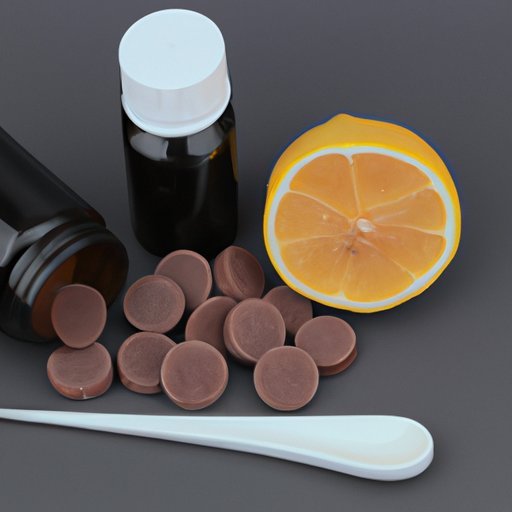
Introduction
Phlegm is a term used to describe the mucus that is produced by the respiratory system. It is made up of water, glycoproteins, and immunoglobulins and is an important part of the respiratory system’s defense against infection and irritation. However, excess phlegm can cause discomfort, difficulty breathing, and other respiratory problems. Common causes of phlegm include respiratory infections, allergies, smoking, and chronic lung conditions.
It’s essential to address phlegm-related problems as they can lead to more severe respiratory conditions and may even be a sign of an underlying medical condition. In the following sections, we will discuss the most effective natural remedies, therapeutic techniques, medications, and lifestyle changes that can help manage phlegm.
Natural Remedies
Natural remedies are a safe and effective way to manage phlegm. Here are some of the most effective natural remedies:
Drinking hot fluids to help loosen phlegm
Drinking hot fluids such as herbal teas, hot water, and warm soups can help loosen phlegm and make it easier to expel. The heat from these fluids helps to increase nasal and bronchial secretions, which helps to flush out mucus.
Using a humidifier to moisten the airways
Using a humidifier can help moisten the airways and reduce the thickness of phlegm. A humidifier releases moisture into the air, which can help to soothe irritated airways and loosen phlegm.
Inhaling steam to help break up phlegm
Inhaling steam is an effective way to break up phlegm and make it easier to cough up. You can inhale steam by taking a hot shower or bath, placing a hot towel over your face, or using a steam inhaler.
Therapeutic Techniques
Therapeutic techniques are designed to help loosen and expel phlegm. Here are some of the most effective therapeutic techniques:
Postural drainage
Postural drainage is a technique in which a person lies down with their head in a downward position to help drain phlegm from the lungs. This technique is most effective when combined with other therapeutic techniques such as chest physical therapy and breathing exercises.
Chest physical therapy
Chest physical therapy is a technique that involves the use of physical movements and percussion to help loosen and mobilize phlegm. This technique is usually performed by a trained therapist and can be highly effective in managing phlegm.
Breathing exercises
Breathing exercises such as deep breathing and controlled coughing can help to loosen and expel phlegm. These exercises can help to improve lung function, increase oxygen flow, and reduce symptoms of phlegm.
Medications
There are several medications available to help manage phlegm. Here are some of the most common medications:
Expectorants to help break up and expel mucus
Expectorants are medications that help to thin the mucus and make it easier to cough up. Examples of expectorants include guaifenesin and acetylcysteine.
Decongestants to help relieve congestion
Decongestants are medications that help to reduce congestion in the respiratory system. Examples of decongestants include phenylephrine, oxymetazoline, and pseudoephedrine.
Mucolytics to help thin the mucus and make it easier to cough up
Mucolytics are medications that help to thin the mucus and make it easier to cough up. Examples of mucolytics include dornase alfa and hypertonic saline.
Lifestyle Changes
Lifestyle changes can be effective in managing phlegm. Here are some of the most effective lifestyle changes:
Quitting smoking to reduce irritation in the airways
Smoking can irritate the airways and worsen symptoms of phlegm. Quitting smoking can help to reduce irritation in the airways and improve respiratory health.
Managing allergies to reduce congestion and inflammation
Allergies can cause congestion and inflammation in the respiratory system, leading to an increase in phlegm production. Managing allergies through medication and avoidance of triggers can help to reduce symptoms of phlegm.
Exercise to improve lung function and clear airways
Regular exercise can improve lung function and help to clear the airways of phlegm. Exercise can also help to strengthen the respiratory muscles, making it easier to expel phlegm.
Prevention and Cautions
Good hygiene habits such as regular hand washing and avoiding contact with sick individuals can help to prevent phlegm-related problems. It’s also important to avoid asthma triggers and to seek medical attention if you experience severe or persistent symptoms of phlegm. If you are experiencing difficulty breathing, chest pain, or coughing up blood, seek emergency medical attention immediately.
Conclusion
In conclusion, phlegm is a common respiratory problem that can be effectively managed through natural remedies, therapeutic techniques, medications, and lifestyle changes. By following the tips outlined in this article, you can reduce symptoms of phlegm and improve your respiratory health. However, it’s important to seek medical attention if you experience severe or persistent symptoms of phlegm. Empower yourself with the knowledge and tools needed to manage your phlegm problem and improve your overall health.




